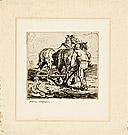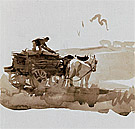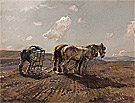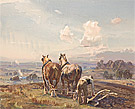Toilers of the land
Heysen identified himself completely with the particular locality, its life and its landscape, of Hahndorf. From 1908 to 1925, he made a concentrated record of this particular region.
His numerous drawings and watercolours depicting agriculture honoured the traditional working life of the Adelaide Hills. The toilers 1920, awarded the Wynne Prize in 1920, was inspired by what Heysen saw on an early morning visit to Hahndorf to collect the mail. The two draught-horses, Polly and Jack, were favourite subjects for him. The curved form of the bending worker rhymes with the horses: showing man and beasts in harmony. The motif recalls the imagery of the 19th century French artist Jean-François Millet.
The ‘toilers of the land’ series also includes Ploughing the field 1920 and portraits of local farmers and townspeople. Heysen knew these people well; he spoke German and talked with them about their daily routines in a hills community.
By the 1920s, the essential character of German labour in the fields had changed with increasing industrialisation and the clearing of land. Heysen’s images are a legacy of the way of life before the mechanisation of farming.




